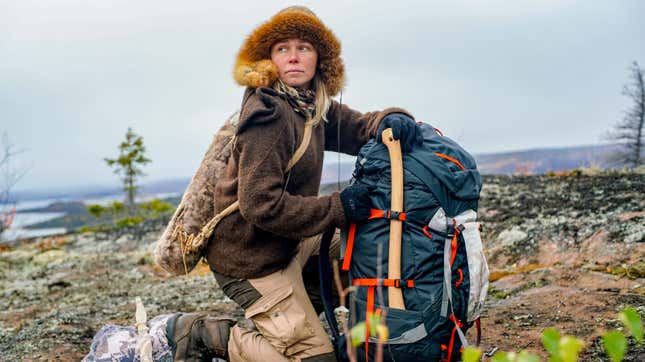Callie Russell, the Woman You Want If You’re Stuck in the Wilderness
Throughout the season, I thought of her as a dream camp counselor.
In DepthIn Depth

Callie Russell, a competitor on the reality-TV series Alone, appears tirelessly optimistic—even with a porcupine quill embedded in her flesh. This season, the History Channel show dropped contestants in the remote Arctic with cameras to film themselves, limited tools for survival, and the promise of a $1 million prize for lasting 100 days. The seven-season series has routinely reduced people to screaming at trees and weeping into their mittens, but Russell consistently gives the camera a big, toothy, and most of all genuine grin in the face of all manner of adversity.
When temperatures plummet and it starts to snow, Russell enthuses to the camera, “GOOD MORNING! Winter has arriiiiiived!” She calls it her “Arctic paradise.” Later—SPOILER ALERT—her big toe blisters and turns purple a mere 11 days away from the big prize, but she doesn’t rail at the injustice of frostbite threatening her shot at winning. Instead, she gives her foot a friendly little pep talk. “C’mon, toe!” she tells it brightly.
It’s somewhat fitting that Russell’s unflappable good cheer found its way onto TV and laptop screens a few months into lockdowns and social distancing when Alone’s seventh season premiered in June. Throughout the season, I thought of her as a dream camp counselor, the kind of person who could rally even a sullen teen out of their sleeping bag. Needless to say, this year sometimes turned me into the sullen teen in need of a dream camp counselor. Russell, who has worked as a trail guide doing “wilderness therapy” for teenagers, was made for that task.
Russell grew up in “the sprawl” of Phoenix, Arizona, she says, but often went camping and hiking on the weekends. When she discovered the unsavory realities of the food industry as a teenager, she vowed not to eat meat unless the animals were “treated with respect,” which led to her learning how to hunt and fish. At 33, she’s spent much of the last decade stringing together various jobs, from teaching wilderness skills workshops to tracking mountain lions for a conservation project, all while living what she calls a “nomadic” lifestyle. “I’d park at a trailhead and cruise out into their wilderness for weeks or months,” she said.
-

-

-

-

-

-

-

-

-

-

-

-

-

-

-

-

-

-

-

-

-

-

-

-

-

-

-

-

-

-

-

-

-

-

-

-

-

-

-

-








































